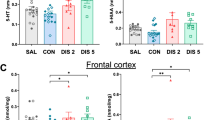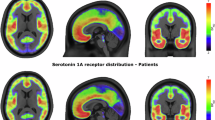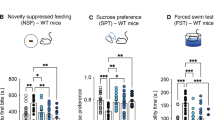Abstract
Selective serotonin reuptake inhibitors like paroxetine (Prx) often requires 4–6 weeks to achieve clinical benefits in depressed patients. Pindolol shortens this delay and it has been suggested that this effect is mediated by somatodendritic 5-hydroxytryptamine (5-HT) 1A autoreceptors. However clinical data on the beneficial effects of pindolol are conflicting. To study the effects of (±)-pindolol–paroxetine administration, we used genetical and pharmacological approaches in 5-HT1A knockout mice (5-HT1A−/−). Two assays, in vivo intracerebral microdialysis in awake mice and the forced swimming test (FST), were used to assess the antidepressant-like effects of this drug combination. Basal levels of extracellular serotonin, 5-HT ([5-HT]ext) in the frontal cortex (FCX) and the dorsal raphe nucleus (DRN) did not differ between the two strains of mice, suggesting a lack of tonic control of 5-HT1A autoreceptors on nerve terminal 5-HT release. Prx (1 and 4 mg/kg) dose-dependently increased cortical [5-HT]ext in both genotypes, but the effects were greater in mutants. The selective 5-HT1A receptor antagonist, WAY-100635 (0.5 mg/kg), or (±)-pindolol (5 and 10 mg/kg) potentiated the effects of Prx (4 mg/kg) on cortical [5-HT]ext in 5-HT1A+/+, but not in 5-HT1A−/− mice. Similar responses were obtained following local intra-raphe perfusion by reverse microdialysis of either WAY-100635 or (±)-pindolol (100 μM each). In the FST, Prx administration dose-dependently decreased the immobility time in both strains of mice, but the response was much greater in 5HT1A−/− mice. In contrast, (±)-pindolol blocked Prx-induced decreases in the immobility time while WAY-100635 had no effect in both genotypes. These findings using 5-HT1A−/− mice confirm that (±)-pindolol behaves as an antagonist of 5-HT1A autoreceptor in mice, but its blockade of paroxetine-induced antidepressant-like effects in the FST may be due to its binding to other neurotransmitter receptors.
Similar content being viewed by others
Log in or create a free account to read this content
Gain free access to this article, as well as selected content from this journal and more on nature.com
or
References
Adell A, Carceller A, Artigas F (1993). In vivo brain dialysis study of the somatodendritic release of serotonin in the Raphe nuclei of the rat: effects of 8-hydroxy-2-(di-n-propylamino)tetralin. J Neurochem 60: 1673–1681.
Artigas F, Celada P, Laruelle M, Adell A (2001). How does pindolol improve antidepressant action? Trends Pharmacol Sci 22: 224–228.
Artigas F, Perez V, Alvarez E (1994). Pindolol induces a rapid improvement of depressed patients treated with serotonin reuptake inhibitors. Arch Gen Psychiatry 51: 248–251.
Artigas F, Romero L, de Montigny C, Blier P (1996). Acceleration of the effect of selected antidepressant drugs in major depression by 5-HT1A antagonists. Trends Neurosci 19: 378–383.
Ase AR, Reader TA, Hen R, Riad M, Descarries L (2001). Regional changes in density of serotonin transporter in the brain of 5-HT1A and 5-HT1B knockout mice, and of serotonin innervation in the 5-HT1B knockout. J Neurochem 78: 619–630.
Ballesteros J, Callado LF (2004). Effectiveness of pindolol plus serotonin uptake inhibitors in depression: a meta-analysis of early and late outcomes from randomised controlled trials. J Affect Disord 79: 137–147.
Bert L, Favale D, Jego G, Greve P, Guilloux J-P, Guiard BP et al (2004). Rapid and precise method to locate microdialysis probe implantation in the rodent brain. J Neurosci Methods 140: 53–57.
Blier P, Bergeron R (1995). Effectiveness of pindolol with selected antidepressant drugs in the treatment of major depression. J Clin Psychopharmacol 15: 217–222.
Blier P, de Montigny C (1994). Current advances and trends in the treatment of depression. Trends Pharmacol Sci 15: 220–226.
Blier P, de Montigny C, Chaput Y (1987). Modifications of the serotonin system by antidepressant treatments: implications for the therapeutic response in major depression. J Clin Psychopharmacol 7: 24S–35S.
Bortolozzi A, Amargos-Bosch M, Toth M, Artigas F, Adell A (2004). In vivo efflux of serotonin in the dorsal raphe nucleus of 5-HT1A receptor knockout mice. J Neurochem 88: 1373–1379.
Casanovas JM, Hervas I, Artigas F (1999). Postsynaptic 5-HT1A receptors control 5-HT release in the rat medial prefrontal cortex. NeuroReport 10: 1441–1445.
Castro ME, Harrison PJ, Pazos A, Sharp T (2000). Affinity of (+/−)-pindolol, (−)-penbutolol, and (−)-tertatolol for pre- and postsynaptic serotonin 5-HT(1A) receptors in human and rat brain. J Neurochem 75: 755–762.
Corradetti R, Laaris N, Hanoun N, Laporte AM, Le Poul E, Hamon M et al (1998). Antagonist properties of (−)-pindolol and WAY 100635 at somatodendritic and postsynaptic 5-HT1A receptors in the rat brain. Br J Pharmacol 123: 449–462.
Cremers TI, Wiersma LJ, Bosker FJ, den Boer JA, Westerink BH, Wikstrom HV (2001). Is the beneficial antidepressant effect of coadministration of pindolol really due to somatodendritic autoreceptor antagonism? Biol Psychiatry 50: 13–21.
Cryan JF, McGrath C, Leonard BE, Norman TR (1998). Combining pindolol and paroxetine in an animal model of chronic antidepressant action—can early onset of action be detected? Eur J Pharmacol 352: 23–28.
Cryan JF, McGrath C, Leonard BE, Norman TR (1999). Onset of the effects of the 5-HT1A antagonist, WAY-100635, alone, and in combination with paroxetine, on olfactory bulbectomy and 8-OH-DPAT-induced changes in the rat. Pharmacol Biochem Behav 63: 333–338.
David DJ, Bourin M, Jego G, Przybylski C, Jolliet P, Gardier AM (2003a). Effects of acute treatment with paroxetine, citalopram and venlafaxine in vivo on noradrenaline and serotonin outflow: a microdialysis study in Swiss mice. Br J Pharmacol 140: 1128–1136.
David DJ, Renard CE, Jolliet P, Hascoet M, Bourin M (2003b). Antidepressant-like effects in various mice strains in the forced swimming test. Psychopharmacology (Berl) 166: 373–382.
Dawson LA, Nguyen HQ (2000). The role of 5-HT(1A) and 5-HT(1B/1D) receptors on the modulation of acute fluoxetine-induced changes in extracellular 5-HT: the mechanism of action of (+/−)pindolol. Neuropharmacology 39: 1044–1052.
Detke MJ, Wieland S, Lucki I (1995). Blockade of the antidepressant-like effects of 8-OH-DPAT, buspirone and desipramine in the rat forced swim test by 5HT1A receptor antagonists. Psychopharmacology (Berl) 119: 47–54.
Dreshfield LJ, Wong DT, Perry KW, Engleman EA (1996). Enhancement of fluoxetine-dependent increase of extracellular serotonin (5-HT) levels by (−)-pindolol, an antagonist at 5-HT1A receptors. Neurochem Res 21: 557–562.
Fornal CA, Martin FJ, Metzler CW, Jacobs BL (1999). Pindolol, a putative 5-hydroxytryptamine(1A) antagonist, does not reverse the inhibition of serotonergic neuronal activity induced by fluoxetine in awake cats: comparison to WAY-100635. J Pharmacol Exp Ther 291: 220–228.
Franklin KB, Paxinos G (1997). The Mouse Brain in Stereotaxic Coordinates. Academic Press Inc.: San Diego, CA.
Gardier AM, Trillat AC, Malagie I, David D, Hascoet M, Colombel MC et al (2001). 5-HT1B serotonin receptors and antidepressant effects of selective serotonin reuptake inhibitors. C R Acad Sci III 324: 433–441.
Gobert A, Millan MJ (1999). Modulation of dialysate levels of dopamine, noradrenaline, and serotonin (5-HT) in the frontal cortex of freely-moving rats by (−)-pindolol alone and in association with 5-HT reuptake inhibitors: comparative roles of beta-adrenergic, 5-HT1A, and 5-HT1B receptors. Neuropsychopharmacology 21: 268–284.
Guiard BP, Przybylski C, Guilloux JP, Seif I, Froger N, De Felipe C et al (2004). Blockade of substance P (neurokinin 1) receptors enhances extracellular serotonin when combined with a selective serotonin reuptake inhibitor: an in vivo microdialysis study in mice. J Neurochem 89: 54–63.
Haddjeri N, de Montigny C, Blier P (1997). Modulation of the firing activity of noradrenergic neurones in the rat locus coeruleus by the 5-hydroxtryptamine system. Br J Pharmacol 120: 865–875.
Haddjeri N, Lavoie N, Blier P (2004). Electrophysiological evidence for the tonic activation of 5-HT(1A) autoreceptors in the rat dorsal raphe nucleus. Neuropsychopharmacology 29: 1800–1806.
Hasegawa R, Murai-Kushiya M, Komuro T, Kimura T (1989). Stereoselective determination of plasma pindolol in endotoxin-pretreated rats by high-performance liquid chromatography. J Chromatogr 494: 381–388.
Heisler LK, Chu HM, Brennan TJ, Danao JA, Bajwa P, Parsons LH et al (1998). Elevated anxiety and antidepressant-like responses in serotonin 5-HT1A receptor mutant mice. Proc Natl Acad Sci USA 95: 15049–15054.
Hjorth S (1996). Pindolol, but not buspirone, potentiates the citalopram-induced rise in extracellular 5-hydroxytryptamine. Eur J Pharmacol 303: 183–186.
Hjorth S, Auerbach SB (1994). Further evidence for the importance of 5-HT1A autoreceptors in the action of selective serotonin reuptake inhibitors. Eur J Pharmacol 260: 251–255.
Hjorth S, Bengtsson HJ, Milano S (1996). Raphe 5-HT1A autoreceptors, but not postsynaptic 5-HT1A receptors or beta-adrenoceptors, restrain the citalopram-induced increase in extracellular 5-hydroxytryptamine in vivo. Eur J Pharmacol 316: 43–47.
Hof PR, Young WG, Bloom FE, Belichenko PV, Celio MR (2000). Comparative Cytoarchitectonic Atlas of the C57BL/6 and 129/Sv Mouse Brains with CD ROM. Elsevier: San Diego, CA.
Hoyer D (1988). Functional correlates of serotonin 5-HT1 recognition sites. J Recept Res 8: 59–81.
Hughes ZA, Dawson LA (2004). Differential autoreceptor control of extracellular 5-HT in guinea pig and rat: species and regional differences. Psychopharmacology (Berl) 172: 87–93.
Invernizzi R, Bramante M, Samanin R (1996). Role of 5-HT1A receptors in the effects of acute chronic fluoxetine on extracellular serotonin in the frontal cortex. Pharmacol Biochem Behav 54: 143–147.
Knobelman DA, Hen R, Blendy JA, Lucki I (2001a). Regional patterns of compensation following genetic deletion of either 5-hydroxytryptamine(1A) or 5-hydroxytryptamine(1B) receptor in the mouse. J Pharmacol Exp Ther 298: 1092–1100.
Knobelman DA, Hen R, Lucki I (2001b). Genetic regulation of extracellular serotonin by 5-hydroxytryptamine(1A) and 5-hydroxytryptamine(1B) autoreceptors in different brain regions of the mouse. J Pharmacol Exp Ther 298: 1083–1091.
Langlois M, Bremont B, Rousselle D, Gaudy F (1993). Structural analysis by the comparative molecular field analysis method of the affinity of beta-adrenoreceptor blocking agents for 5-HT1A and 5-HT1B receptors. Eur J Pharmacol 244: 77–87.
Malagie I, Trillat AC, Bourin M, Jacquot C, Hen R, Gardier AM (2001). 5-HT1B autoreceptors limit the effects of selective serotonin re-uptake inhibitors in mouse hippocampus and frontal cortex. J Neurochem 76: 865–871.
Martinez D, Broft A, Laruelle M (2000). Pindolol augmentation of antidepressant treatment: recent contributions from brain imaging studies. Biol Psychiatry 48: 844–853.
Martinez D, Hwang D, Mawlawi O, Slifstein M, Kent J, Simpson N et al (2001). Differential occupancy of somatodendritic and postsynaptic 5HT(1A) receptors by pindolol: a dose-occupancy study with [11C]WAY 100635 and positron emission tomography in humans. Neuropsychopharmacology 24: 209–229.
Mayorga AJ, Dalvi A, Page ME, Zimov-Levinson S, Hen R, Lucki I (2001). Antidepressant-like behavioral effects in 5-hydroxytryptamine(1A) and 5-hydroxytryptamine(1B) receptor mutant mice. J Pharmacol Exp Ther 298: 1101–1107.
Miguez JM, Paz-Valinas L, Miguez I, Aldegunde M (2002). Somatodendritic action of pindolol to attenuate the paroxetine-induced decrease in serotonin release from the rat ventral hippocampus: a microdialysis study. Naunyn Schmiedebergs Arch Pharmacol 365: 378–387.
Moret C, Briley M (1997). Effects of milnacipran and pindolol on extracellular noradrenaline and serotonin levels in guinea pig hypothalamus. J Neurochem 69: 815–822.
Moser PC, Sanger DJ (1999). 5-HT1A receptor antagonists neither potentiate nor inhibit the effects of fluoxetine and befloxatone in the forced swim test in rats. Eur J Pharmacol 372: 127–134.
Newman-Tancredi A, Chaput C, Gavaudan S, Verriele L, Millan MJ (1998). Agonist and antagonist actions of (−)pindolol at recombinant, human serotonin1A (5-HT1A) receptors. Neuropsychopharmacology 18: 395–398.
O’Neill MF, Conway MW (2001). Role of 5-HT(1A) and 5-HT(1B) receptors in the mediation of behavior in the forced swim test in mice. Neuropsychopharmacology 24: 391–398.
Parks CL, Robinson PS, Sibille E, Shenk T, Toth M (1998). Increased anxiety of mice lacking the serotonin1A receptor. Proc Natl Acad Sci USA 95: 10734–10739.
Parsons LH, Kerr TM, Tecott LH (2001). 5-HT(1A) receptor mutant mice exhibit enhanced tonic, stress-induced and fluoxetine-induced serotonergic neurotransmission. J Neurochem 77: 607–617.
Petit-Demouliere B, Chenu F, Bourin M (2005). Forced swimming test in mice: a review of antidepressant activity. Psychopharmacology (Berl) 177: 245–255.
Plenge P, Mellerup ET (2003). Pindolol and the acceleration of the antidepressant response. J Affect Disord 75: 285–289.
Porsolt RD, Bertin A, Jalfre M (1977). Behavioral despair in mice: a primary screening test for antidepressants. Arch Int Pharmacodyn Ther 229: 327–336.
Ramboz S, Oosting R, Amara DA, Kung HF, Blier P, Mendelsohn M et al (1998). Serotonin receptor 1A knockout: an animal model of anxiety-related disorder. Proc Natl Acad Sci USA 95: 14476–14481.
Rasmussen K, McCreary AC, Shanks EA (2004). Attenuation of the effects of fluoxetine on serotonergic neuronal activity by pindolol in rats. Neurosci Lett 355: 1–4.
Redrobe JP, MacSweeney CP, Bourin M (1996). The role of 5-HT1A and 5-HT1B receptors in antidepressant drug actions in the mouse forced swimming test. Eur J Pharmacol 318: 213–220.
Romero L, Bel N, Artigas F, de Montigny C, Blier P (1996). Effect of pindolol on the function of pre- and postsynaptic 5-HT1A receptors: in vivo microdialysis and electrophysiological studies in the rat brain. Neuropsychopharmacology 15: 349–360.
Sprouse J, Braselton J, Reynolds L (2000). 5-HT(1A) agonist potential of pindolol: electrophysiologic studies in the dorsal raphe nucleus and hippocampus. Biol Psychiatry 47: 1050–1055.
Steru L, Chermat R, Thierry B, Simon P (1985). The tail suspension test: a new method for screening antidepressants in mice. Psychopharmacology (Berl) 85: 367–370.
Tatarczynska E, Klodzinska A, Chojnacka-Wojcik E (2002). Effects of combined administration of 5-HT1A and/or 5-HT1B receptor antagonists and paroxetine or fluoxetine in the forced swimming test in rats. Pol J Pharmacol 54: 615–623.
Tatarczynska E, Klodzinska A, Stachowicz K, Chojnacka-Wojcik E (2004). Effects of a selective 5-HT1B receptor agonist and antagonists in animal models of anxiety and depression. Behav Pharmacol 15: 523–534.
Titeler M, Lyon RA, Davis KH, Glennon RA (1987). Selectivity of serotonergic drugs for multiple brain serotonin receptors. Role of [3H]-4-bromo-2,5-dimethoxyphenylisopropylamine ([3H]DOB), a 5-HT2 agonist radioligand. Biochem Pharmacol 36: 3265–3271.
Toth M (2003). 5-HT1A receptor knockout mouse as a genetic model of anxiety. Eur J Pharmacol 463: 177–184.
Tsuchihashi H, Nakashima Y, Kinami J, Nagatomo T (1990). Characteristics of 125I-iodocyanopindolol binding to beta-adrenergic and serotonin-1B receptors of rat brain: selectivity of beta-adrenergic agents. Jpn J Pharmacol 52: 195–200.
Wieland S, Lucki I (1990). Antidepressant-like activity of 5-HT1A agonists measured with the forced swim test. Psychopharmacology (Berl) 101: 497–504.
Zgombick JM, Bard JA, Kucharewicz SA, Urquhart DA, Weinshank RL, Branchek TA (1997). Molecular cloning and pharmacological characterization of guinea pig 5-HT1B and 5-HT1D receptors. Neuropharmacology 36: 513–524.
Acknowledgements
We thank the participation of Isabelle Seif for the genotyping of animals and for her scientific support. This work has been supported by the technical assistance of the Animal Care Facility of the ‘Institut Fédératif de Recherche—IFR75’ of the Paris XI University.
Author information
Authors and Affiliations
Corresponding author
Additional information
Supplementary Information accompanies the paper on the Neuropsychopharmacology website (http://www.nature.com/npp).
Supplementary information
Rights and permissions
About this article
Cite this article
Guilloux, JP., David, D., Guiard, B. et al. Blockade of 5-HT1A Receptors by (±)-Pindolol Potentiates Cortical 5-HT Outflow, but not Antidepressant-Like Activity of Paroxetine: Microdialysis and Behavioral Approaches in 5-HT1A Receptor Knockout Mice. Neuropsychopharmacol 31, 2162–2172 (2006). https://doi.org/10.1038/sj.npp.1301019
Received:
Revised:
Accepted:
Published:
Issue date:
DOI: https://doi.org/10.1038/sj.npp.1301019
Keywords
This article is cited by
-
β-Catenin Role in the Vulnerability/Resilience to Stress-Related Disorders Is Associated to Changes in the Serotonergic System
Molecular Neurobiology (2020)
-
New arylpiperazine derivatives with antidepressant-like activity containing isonicotinic and picolinic nuclei: evidence for serotonergic system involvement
Naunyn-Schmiedeberg's Archives of Pharmacology (2019)
-
Alterations in alpha5* nicotinic acetylcholine receptors result in midbrain- and hippocampus-dependent behavioural and neural impairments
Psychopharmacology (2016)
-
P5-HT1A receptors in mood and anxiety: recent insights into autoreceptor versus heteroreceptor function
Psychopharmacology (2014)
-
Response on: Chlorpheniramine exerts anxiolytic-like effects and activates prefrontal 5-HT systems in mice (Miyata S. et al., Psychopharmacology, 2009)
Psychopharmacology (2011)



